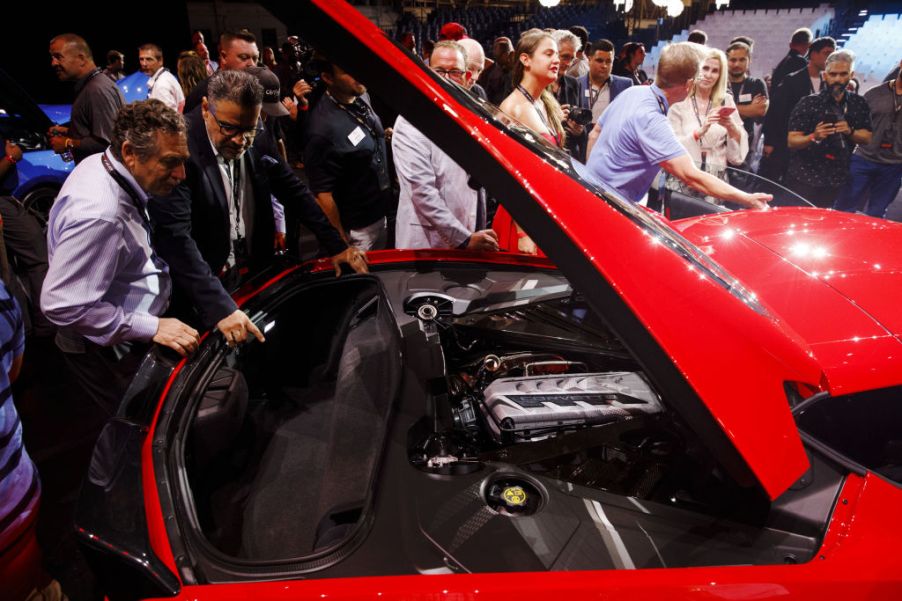
How Fast Is the 2020 Chevrolet Corvette Stingray?
The unveiling of the 2020 Chevrolet Corvette Stingray in late July 2019 provided vital information about this highly-anticipated car. We learned what it looked like unwrapped, some of its basic design and engineering features and, most importantly, its acceleration statistic of 3.0 seconds for zero to 60 miles per hour. But we don’t have a top speed stat for the Stingray, and that’s a fundamental way of determining just how fast a car is.
It’s hard to tell if Chevrolet’s decision-makers believe that the acceleration record says enough about the car’s quickness, at least for now. GM President Mark Reuss told the press at the unveiling that the automaker still need to test the Corvette for top speed, according to GM Authority.
It seems odd because the implication here is that a top speed benchmark isn’t as meaningful to Chevy as acceleration is. We’d like to think that top speed stat would be a priority, especially since several supercar rivals have already hit 200 mph or higher. But maybe we should take Mark Reuss at his word that Chevy really is testing the mid-engine supercar before it releases this number.
Either way, all we have right now is one small but crucial bit of data about the Chevrolet Stingray’s acceleration. Until Chevy discloses more information, we’ll have to look at other factors to piece together clues as to how fast the car might actually be.
Factors that contribute to the Stingray’s speed
The first factor that is hard to miss is that Chevy equipped the Stingray with the Z51 Performance Package to achieve the 3.0-second record. We can’t be sure what kind of speed the car would have reached without it. What we do know is that this package boosts the performance of the base model through stiffer suspension, grippier tires that have a higher speed rating, better engine cooling, enhanced exhaust features, and a specific axle ratio for better acceleration.
Besides the performance package, other major factors contributing to the car’s speed are a powerful engine, weight, aerodynamic design, and gearing.
For example, the naturally-aspirated LT2 6.2-liter V8 engine has plenty of displacement. With the Stingray making 495 hp and 470 lb-ft of torque, it easily meets the current gold standard of power for sports cars.
The supercar has a dry weight of 3,366 pounds, which means if we add in passengers plus consumables such as oil, fuel, and coolant, it might have a curb weight closer to 3,600. That’s slightly heavier than the curb weight of a Ford GT or the new Toyota Supra. But it’s still reasonably light for its class, so its performance shouldn’t be negatively affected.
The Stingray’s A-pillar, fighter jet-style shape is streamlined for decreased wind and rolling resistance.
And while Chevy hasn’t divulged specific gear information, it did hint that the first gear was very short, meaning that the car can get to speed quickly with minimal torque.
These factors—and some other subtle refinements such as a dry-sump oil system and direct fuel injection—add to up to produce a supercar with rapid acceleration as well as the potential to catch its competitors that have already hit the 200-mph mark. Let’s find out what it will take for the Stingray to chase them down.
Going for 200 mph?
To put the question of speed in perspective, we can look at the C7 base model Stingray, which reached a top speed of 187 mph, while the same-generation Stingray with the Z51 Performance Package only topped out at 186. The seventh-generation Z06 hit 205 mph, and the ZR1 reached 212 mph. With the baseline set, we know that the 2020 version will need to be faster than both the base model of its predecessor and maybe the quicker Z variants.
The pressure to meet a top speed benchmark will become much more intense if Chevy decides to nudge the Stingray into the elite ranks of the 200-mph club. The new Corvette will need to elbow past such heavy-hitters as the Ferrari 488 GTB that has a top speed of 205 mph, the McLaren Senna at 208 mph, and the Lamborghini Huracán at 212 mph.
Domestic contenders include the Dodge Challenger SRT Hellcat Redeye that hits 203 mph and the Ford GT that tops at a blistering 216 mph.
Quick acceleration but how fast, really?
With the 3.0 second stat in mind, we have enough information to confirm that the 2020 Corvette Stingray is a fast-accelerating supercar. Granted, it doesn’t accelerate nearly as quickly as the Audi R8 V10 Plus does at 2.6 seconds.
But the Stingray is faster than a number of cars in its class. And it’s still faster than most cars out on the highway today.
Whether Chevy will use the Stingray with the Z51 Performance Package or another Z variant to reach the 200-mph mark is still undetermined. The 2020 Corvette Stingray has everything it needs to reach that speed, though, and we’re hoping that Chevy does the testing to get it there as soon as possible.


